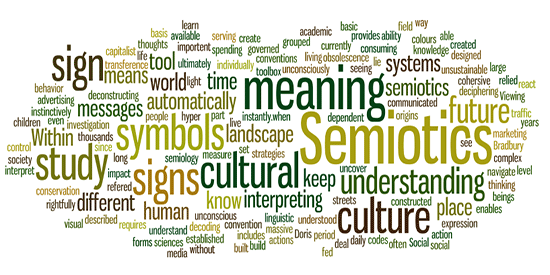 Some students of semiotics seem to be irritated by the success of the meme.
(e.g. Kilpinen, E. (2014)).
Semiotics seems to be much more popular than memetics, and the term 'sign'
seems to be much more popular than
the term 'meme'. However, the term 'sign' does appear to have lost some
important ground to the term 'meme'. Here's my take on how the meme
managed to get a foothold.
Some students of semiotics seem to be irritated by the success of the meme.
(e.g. Kilpinen, E. (2014)).
Semiotics seems to be much more popular than memetics, and the term 'sign'
seems to be much more popular than
the term 'meme'. However, the term 'sign' does appear to have lost some
important ground to the term 'meme'. Here's my take on how the meme
managed to get a foothold.Semiotics claims to be older than memetics. Semiotics became popular in the 1970s and 1980s - but claims roots going beck centuries. However, until the 1970s there wasn't very much in the way of semiotics publications. The founders of the various schools of cultural evolution may have ignored semiotics, because it had yet to become popular at that time.
By the 1970s, semiotics had basically failed to produce a school of cultural evolution. There was no explanation of how signs evolved based on broadly Darwinian principles. As Terry Deacon put it:
Until now, classic semiotic theories have not had much to say about why certain signs persist and others do not, or why certain semiotic systems evolved the forms they now exhibit....and...
The meme concept has generated recent excitement precisely because it seems to offer hope of providing something that other theories of social and semiotic processes have not succeeded in providing. It addresses the process of semiosis, i.e., the dynamical logic of how the symbolic and concrete constituents of culture arise, assume the forms they assume, and evolve and change over time.
Retrospectively, we can see that application of evolutionary biology to human communication mostly arose outside of semiotics - mainly from those trained in evolutionary biology and population genetics.
Perhaps the bypassing of the term 'sign' by cultural evolutionists was inevitable. The term 'sign' - in common parlance - comes with an associated object that is signified by the sign. Culture contains many signs - for example, letters, words and ideograms. However there are also non-signs: for example, knots, cups and fire. These have no obvious referents - they just are. For the concept of 'sign' to be useful as a unit to cultural evolutionists all culture would need to be signs. However, that violates the common dictionary definition of 'sign'.
The tpyical semiotics solution to this problem is to expand the definition of 'sign' to include knots, cups and fire - and indeed, practically anything. This is sometimes called 'pansemiotics'. If you do this, then semiotics becomes very general. Of course the problem is then that the original meaning of the term 'sign' has got lost. It is sometimes permissible to give common language terms counter-intuitive technical meanings. However, here, I think it just leads to pointless confusion.
As for the claim that the concept of 'meme' misses out the concepts of semantics and observation: this is just sour grapes on the part of the semiotics folk. One might reply that meaning and observers aren't part of the meme because they are context-dependent.










Is not a sign a phylum of meme?
ReplyDeleteThat makes sense, yes. However, the semiotics folk claim that 'sign' is more general - since it includes both symbol and meaning - whereas the term 'meme' is symbol-only.
DeleteThere's also Pierce's pan-semiotics - in which all animal communication qualifies as being a 'sign'.
OK, sign might be more primitive than 'meme', as signalling via phenotype could be an entirely genetic expression and not a result of memetic evolution.
ReplyDeleteI sort of wandered into this specific entry off of the internet somehow and am a bit unclear as to the magisteria of semiotics vs memetics. I guess from the wikipedia article it seems that memetics had kind of a split between 'externalists' and 'internalists'. The internalists stuck to memes as being ideas instantiated on brain-stuff whereas the externalists defined memes in terms of strictly external things like, stop signs, I guess, and its kind of hard for me to tell the difference per se between 'external memes' and semes, other than I guess the seme comes with more baggage to it? I saw something about semes being kind of a glued together amalgam of the idea, and the person interpreting the idea, and their interpretation of it, or... something. I also wonder where other modes of bending ideas and thinking come into all this. like reasoning from analogy seems like a kind of 'reproduction' of a solution from one domain to another domain with an attending translation... it seems like 'just copying' ideas is maybe only one type of thing a brain might do with an idea? I mean I guess you could also make the claim that reasoning by analogy is also a copied behavior, albeit a mental one, and thus kind of contain it within memes, but I feel like it is maybe lower level than that for humans at least.... there's a neat hofstadter lecture called 'analogy as the fuel and fire of cognition'. eh, I'm not sure where I'm going with this. Would love to hear your thoughts tho'. Thanks! XD
ReplyDelete^ And I guess you could also say that the meme after being 'copied' to this other domain was the 'same meme'... but then how far can you bend a meme and have it be 'the same' (and thus a copy of the original)...
Delete